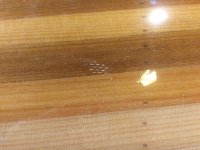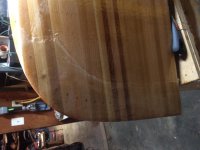I follow pretty much the same process as Alan suggests, definitely ROS, but I use 120 grit, but concur that if the hull finish is rough, you will likely have to drop grit to get it level.
If I cut through then I just use a final thin coat of epoxy (roller with foam brush tip off), which usually comes out like glass, which is then lightly sanded (ROS) using 150 (this coat is so smooth I don't need anything coarser than this) to take all of the shine off ..... I find it goes very quick even at 150 and seems to make the first varnish coat go on smoother and easier .
Whether you chose to use a thin recoat of epoxy or not, after cutting into the FG, is a bit of a crap shoot .... if it's not too deep or the glass doesn't fray, then varnish will make it disappear, however, if that's not the case, the glass will show after the varnish dries. Unfortunately, when you have sanded too far into the glass is a judgement call, our terms of "deep" "light" are all up for debate, the rule I use is that if I can clearly see the glass weave, I have gone too far and I will use an extra thin coat to reseal.
After the amount of work invested at that point I usually err on the side of caution and do the recoat if I have any doubts about abraded areas. The key is to use a "thin" coat, you aren't trying to fill anything at this point, just reseal the hull. The up side of this is that the new coat will be almost glass like, which can be a real ego booster.
Brian



